Jiuzhaigou is located in the Aba Tibetan and Qiang
Autonomous Prefecture of Sichuan Province, the branch
of white ditch and named for contain nine Tibetan
villages. The average altitude is more than 2 kilometers,
primeval forest and 108 lakes distributed in it. At
there, the scenery is excellent so got the reputation
of "fairy-tale world", also reside the giant
panda, golden monkey, takin, sika deer and other rare
animals. It was recorded in the World Heritage List
as the national key scenic spot.
Jiuzhaigou is a highland humid climate with the snow
in peak all year around. All the four seasons are
suitable for tour, especially in autumn. In any reason,
the scenery of Jiuzhaigou is so charming. In spring,
snow and ice melting, the water line rising and flowers
blooming; in summer, full of lush forest and gentle
wind blowing; in autumn, it's the most brilliant season
with colorful leaves leave in everywhere; in winter,
under the snow everything is quiet and full of poetic.
The main scenic spots include: Jiuzhaigou Valley Scenic
and Historical Interest Area, Huanglong Park and Historical
Interest Area, Mounigou Valley, Fairy Pool Park and
Mt. Sigunianshan. The local ethnic flavor foods are
Roast sheep, Hand-grilled steak, Za noodles, Potato
Ciba, Highland barley wine, yak meat and so on.
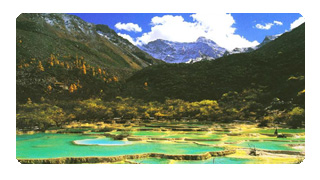 Huanglong
Park and Historical Interest Area
Huanglong
Park and Historical Interest Area
Huanglong (Yellow Dragon) Park is located in northern
Sichuan's Aba Tibetan and Qiang Autonomous Prefecture,
and is a neighbor of Jiuzhaigou. It was named after
the ancient Huanglong Temple.
The Huanglong Temple is situated on the top of the
scenic area. South of the temple is Xuebaoding, the
main peak of the snow-capped Minshan Mountain which
stands 5,588 meters above sea level. It is covered
in snow all year round.
The most remarkable vista is the Huanglong Valley,
which is noted for its unique open limestone landscape.
The main attraction of the valley is the 3.6-kilometer
long and 30 to 70-meter-wide pale yellow calcareous
deposits. At the end of the valley, water from melting
snow mixes with limestone water from underground,
which flows down the mountain terraces and deposits
the calcium carbonate from the water on the rocks
and fallen branches in its path. The calcium carbonate
develops into solid, low limestone banks and as a
result of chemical reactions, different kinds of calcareous
deposits look like gold flashing in the sunlight.
When the water runs down the slopes, it appears like
a yellow dragon flying down the mountain. The water
then flows into two separate streams, creating colorful
lakes and waterfalls and forming a lake group. The
water is crystal clear and the mineral deposits at
the lake's bottom look like jade.
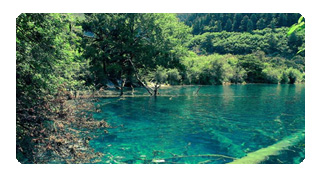 Mounigou
Valley
Mounigou
Valley
Mounigou Valley is located in Songpan County and contains
Zhaga Waterfall along with the nearby Erdaohai National
Park. There are rich natural resources in this area
as well as some rare animals like the Giant Panda
and the Canary Monkey. All these contribute to the
dreamlike, otherworldly 'fairyland' that the Chinese
call Mounigou.
Zhaga Waterfall holds the reputation of being the
most famous calcified waterfall in China. It stands
104 meters high and 35 meters wide, and the water
speeds down at the rate of 23 meters per second.
In addition to Erdaohai and Zhaga Waterfall, this
5 km valley is home to Swan Lake, Feicui Lake, Rhinoceros
Lake and more.
Zhaga Waterfall
There are many colorful pools and waterfalls in Zhaga
Valley. The various sounds of waterfalls echo throughout
the forest, creating impressive sprays and mists.
Zhaga Waterfall is among the most beautiful waterfalls,
but it also feels like the most supernatural and mysterious.
It is the largest limestone waterfall in China, standing
93.2 meters (306 feet) high, 35 meters (38 yards)
wide, and has an elevation of 3,270 meters (10,728
feet). In the upper ends of the waterfall is a lake,
and in the lower end is a lakebed that has many levels,
which resembles a staircase. When the waterfall rushes
down the limestone steps, it creates a large spray
and a roaring sound. On a sunny day, the waterfall's
cliffs sparkle with all colors of the rainbow.
When wandering along the path of the valley, you not
only see numerous flowers in bloom, but also bamboo
forest. It is in these bamboo forests that the pandas
reside. Also along the 5 kilometer (3.1 mile) valley,
you can find hundreds of colorful, intriguing pools
of water, all various shapes and sizes.
Erdaohai National Park
Erdaohai National Park hides in a jungle and has an
area of 6,800 square meters (1.68 acres). Visitors
can get here by horse or on foot from the Zhaga Waterfall.
The upper part of Erdaohai Lake is so clear that people
can see little fishes swimming in the water.
There are over 400 other lakes in the area, including
Swan Lake and Ginseng Lake, and visitors can also
explore some mysterious caves. Among these caves,
the most impressive one is called Xuannu Palace.
There are many other things to see, including Tibetan
Buddhist temples and Flower Lake.
Tibetan Buddhism is an essential part of the local
residents' daily life. There are two main temples
in this area: Xiaobao Temple and Hou Temple, which
belong to Gulug (Yellow hat) of Tibetan Buddhism.
Flower Lake got its name because of the hundreds of
blossoming flowers that grow on the surface on the
lake, which change colors according to the season.
The Horseback riding tour is another attraction in
Mounigou Valley. Since it started in 1982, more and
more tourists choose this method to appreciate the
amazing valley. Visitors have the option of staying
in campsites or in small inns and can modify the tour
according to their needs.
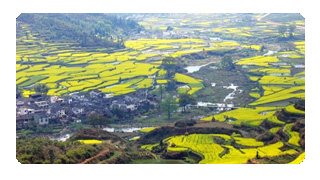 Fairy
Pool Park
Fairy
Pool Park
The Fairy Pool Park is a renowned attraction in Jiuzhaigou.
It is situated about 49 kilometers (30 miles) from
the entrance to Jiuzhaigou Valley Scenic and Historical
Interest Area. In Tibetan, the Fairy Pool Scenic Area
is called Nen'en Sangcuo, meaning 'a place where fairies
bathe'.
The Fairy Pool Park is comprised of 2,000 alpine lakes
and limestone pools that are scattered throughout
the lush forest. The most celebrated natural attractions
are the Golden and Silver Beach, the Double-Dragon
Pool, the Divine Frog Sea, the Blue Dragon Sea, the
Kermes Brook and the limestone waterfalls. In addition
to the pools, the area has the best preserved virgin
forest and the greatest density of arrow bamboo in
Sichuan Province. Many rare animals such as pandas,
Tibetan antelopes, and golden monkeys roam the forest.
The Fairy Pools are celebrated for its three huge
colorful pools and a group of small white and pale
yellow stone dams. The color comes from calcified
stones in the water that resemble agates, corals,
and pearls. The three pools are known as the Big Lake,
the Green Sea and the Big Sea, each covering an area
of about 6,667 square meters (2 acres). The Rippling
Golden Stream features stone dams, colorful pools,
limestone streams, and waterfalls.
Historical and cultural attractions in the scenic
area include the Horses Passage where Songtsen Gampo
and his troops once passed and the Tianbao Museum.
Songtsen Gampo (617-649 or 650) was the founder of
the Kingdom of Tibet in ancient China. Some inns and
tents have been built in the willow forests along
this historic path for tourism purposes. Activities
including horse races, barbecues, bonfires, and folk
performances given by Tibetan artists are held here.
In Tianbao Museum, tourists can see the local lumbermen's
cottages and tools.Visitors can plant or adopt trees
to contribute to the environmental protection of this
scenic area.
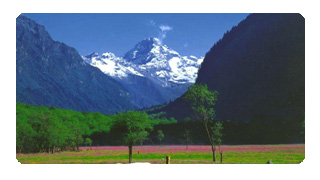 Mt.
Siguniangshan
Mt.
Siguniangshan
The Mt. Siguniangshan Park is an unspoiled wilderness
park located in western Sichuan Province, near the
town of Rilong in Aba Autonomous Prefecture. Mt. Siguniangshan
consists of four adjacent mountain peaks and got its
unusual name from a local Tibetan legend that says
the four peaks are the embodiments of four pretty
girls. At 6,250 meters, (about 20,500 feet) the highest
peak of Mt. Siguniangshan is known as 'The Little
Girl' or 'Queen Peak'.
Mt. Siguniangshan is famed for its steep and imposing
peaks. The high meadows are wonderful throughout all
four seasons, and hundreds of wildflowers burst forth
in spring, giving way to lush green trees and grass
in summer. In the autumn, the leaves on the trees
blaze in color, heralding the coming snows of winter.
Because of the clear blue sky, the thick forests,
the verdant grassland, and the murmuring streams,
Siguniangshan is sometimes known as the 'Alps of the
East'. You may even think you are in southern Europe.
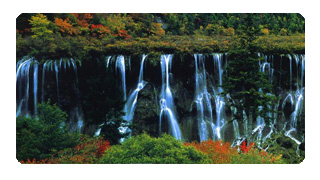 Jiuzhaigou
Valley Scenic and Historical Interest Area
Jiuzhaigou
Valley Scenic and Historical Interest Area
It is said that if there were heaven on earth, Jiuzhaigou
is one of them. Jiuzhaigou is a magnificent natural
masterpiece that boasts dreamlike scenery and abundant
natural resources. It combines blue lakes, waterfalls,
lush forests, snow-covered mountains, and the traditional
folk customs of the Tibetan and Qiang peoples. In
fact, Jiuzhaigou got its name from the nine villages
in the area of Tibetan origin and it is even regarded
as holy by the Tibetan people.
Jiuzhaigou is located in Nanping County to the north
of Chengdu. The region covers more than 600 kilometers
(about 280 miles) and includes areas such as Shuzheng
Valley, Rize Valley, Zechawa Valley and Zharu Valley.
The major points of interest include limestone lake
groups, waterfalls and other waterscapes, and twelve
summits, and make Jiuzhaigou a must-see when in China.
In addition, there are abundant flora and fauna species
in the area. The natural forest covers an area of
nearly 30,000 hectares (about 74,132 acres), including
2,576 higher plant species (24 species of national
protected plants) and over 400 lower plant species
(212 species of algae). The diversity of flora has
provided a good environment for wild animals to thrive.
There are 170 species of vertebrates, 141 species
of birds, and 17 species of rare animals.
Legend has it that long ago the mountain god Dago
had a crush on the goddess Semo, and he gave her the
gift of a mirror made of wind and cloud. However,
the devil appeared to give Semo trouble. Accidentally,
Semo broke the mirror into 108 pieces which fell down
to the earth and turned into 108 colorful lakes. The
lakes are called Haizi by the locals.



